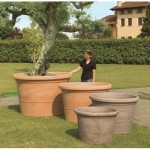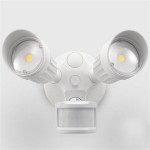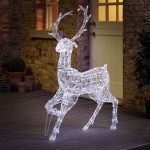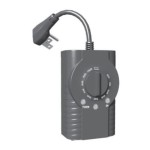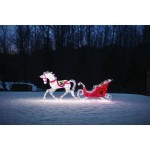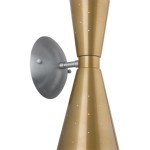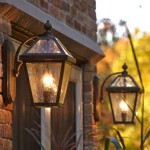Illuminating Your Outdoor Spaces: A Guide to Outdoor Table Lights
Outdoor table lights are designed to bring ambiance and functionality to patios, decks, and other exterior living areas. These portable lighting solutions offer a versatile way to enhance outdoor experiences, extending usability well into the evening hours. Understanding the variety of available options and their respective features enables the selection of the most suitable lights for specific needs and aesthetic preferences.
Unlike fixed outdoor lighting fixtures, outdoor table lights offer unparalleled flexibility. They can be easily relocated to suit different seating arrangements, events, or simply to adjust the overall atmosphere. This adaptability makes them ideal for homeowners and businesses seeking a dynamic and customizable outdoor lighting solution. Furthermore, the installation process is often minimal, requiring no wiring or professional assistance, making them a practical choice for renters or those seeking a quick and easy lighting upgrade.
The market offers a wide array of outdoor table lights, ranging from classic lanterns to modern, minimalist designs. Materials used in their construction also vary significantly, impacting both their durability and aesthetic appeal. Metals like stainless steel and aluminum provide robustness and resistance to corrosion, while materials like resin and plastic offer lightweight and cost-effective alternatives. The selection of the appropriate material should consider local climate conditions and the desired level of maintenance.
Understanding the Different Types of Outdoor Table Lights
Outdoor table lights can be categorized based on their power source, design style, and features. Each type offers distinct advantages and is best suited for particular applications. A thorough understanding of these categories is crucial for making informed purchasing decisions.
Battery-Powered Lights: These operate on disposable or rechargeable batteries. They offer maximum portability and are not constrained by proximity to electrical outlets. LED technology is commonly integrated, providing energy efficiency and extended run times. Battery-powered lights are ideal for locations where access to power is limited or nonexistent, such as remote corners of a garden or temporary event setups. The lifespan of the batteries is a critical factor to consider, as is the availability and cost of replacements. Rechargeable options, while initially more expensive, can offer long-term cost savings and reduce environmental impact.
Solar-Powered Lights: Solar-powered lights harness energy from the sun to illuminate outdoor spaces. They typically feature a photovoltaic panel that converts sunlight into electricity, which is then stored in a rechargeable battery. These lights are environmentally friendly and require no external power source, making them ideal for eco-conscious consumers. However, their performance is dependent on the amount of sunlight they receive. In regions with limited sunlight, their brightness and runtime may be reduced. Solar-powered lights are best suited for areas with ample sun exposure and a preference for sustainable lighting solutions. They often come equipped with light sensors, automatically turning on at dusk and off at dawn.
Electric Lights (Plug-In): These lights require a direct connection to an electrical outlet. While they lack the portability of battery-powered and solar-powered options, they offer consistent brightness and performance. Electric lights are often used in covered patios or decks where outlets are readily available. Considerations for their use include the availability of weatherproof outlets and the need for extension cords if the desired location is not directly adjacent to an outlet. Electric lights often offer more advanced features, such as dimming capabilities and integrated timers.
Key Features to Consider When Choosing Outdoor Table Lights
Beyond the power source, several key features influence the performance and suitability of outdoor table lights. These features include brightness, weather resistance, material durability, and aesthetic design. Evaluating these features will ensure that the chosen lights meet specific needs and preferences.
Brightness and Light Output: The brightness of an outdoor table light is typically measured in lumens. The appropriate lumen output depends on the intended use. For creating ambiance, lower lumen lights are sufficient. For task lighting, such as reading or dining, brighter lights are recommended. LED lights offer a wide range of lumen outputs and are generally more energy efficient than traditional incandescent bulbs. Consider the color temperature of the light as well. Warmer color temperatures (around 2700K) create a cozy and inviting atmosphere, while cooler temperatures (around 5000K) provide brighter, more focused illumination.
Weather Resistance: Outdoor table lights are exposed to the elements, so weather resistance is a crucial factor. Look for lights with an IP (Ingress Protection) rating of IP44 or higher, indicating protection against splashing water and solid objects. Lights designed for outdoor use should be constructed from materials that are resistant to rust, corrosion, and fading. Consider the local climate when evaluating weather resistance. In coastal areas, salt spray can accelerate corrosion, requiring more robust materials. In areas with frequent rainfall, watertight seals and drainage features are essential.
Material and Durability: The materials used in the construction of outdoor table lights impact their durability and longevity. Stainless steel and aluminum are popular choices for their resistance to corrosion. Resin and plastic offer lightweight and cost-effective alternatives, but they may not be as durable as metal options. Glass shades should be tempered or shatter-resistant to withstand accidental impacts. The overall construction quality of the light is also important. Look for sturdy bases and secure connections to ensure that the light remains stable and functional over time.
Maintaining and Caring for Outdoor Table Lights
Proper maintenance is essential for extending the lifespan and performance of outdoor table lights. Regular cleaning and periodic inspections can prevent damage and ensure that the lights continue to function optimally. The specific maintenance requirements vary depending on the type of light and the materials used in its construction.
Cleaning and Storage: Regularly clean outdoor table lights to remove dirt, dust, and debris. Use a soft cloth and mild detergent to wipe down the surfaces. Avoid using abrasive cleaners or scouring pads, as these can scratch or damage the finish. For lights with glass shades, use a glass cleaner specifically designed for outdoor use. During periods of inclement weather or when the lights are not in use, store them in a dry, protected location. This will prevent rust, corrosion, and other forms of damage. Battery-powered lights should have their batteries removed before storage to prevent corrosion.
Bulb Replacement: When replacing bulbs in outdoor table lights, use the correct type and wattage. Refer to the manufacturer's instructions for specific recommendations. LED bulbs are generally more energy efficient and have a longer lifespan than traditional incandescent or halogen bulbs. Before replacing a bulb, ensure that the light is turned off and unplugged from the power source. Handle bulbs carefully to avoid breakage. Dispose of old bulbs properly, following local regulations for hazardous waste disposal.
Troubleshooting Common Issues: Common issues with outdoor table lights include flickering lights, dim lighting, and lights that fail to turn on. Flickering lights can be caused by loose connections or faulty bulbs. Check the connections and replace any damaged bulbs. Dim lighting can be a sign of low battery power or a malfunctioning bulb. Replace the batteries or bulb as needed. If a light fails to turn on, check the power source and the switch. Ensure that the light is properly connected to the power source and that the switch is in the "on" position. If the problem persists, consult a qualified electrician.
By considering the types of outdoor table lights, their key features, and proper maintenance practices, individuals can effectively illuminate and enhance their outdoor living spaces, creating inviting and functional environments for relaxation and entertainment.

Outdoor Light Post Terrain
Light Your Patio Cordless Mini Lamp 2 Pack Costco

Lunar Cordless Led Indoor Outdoor Table Light Hadley

Buy Whole China Hot Outdoor Waterproof Ip54 Wireless Usb Led Rechargeable Cordless Table Lamp Bar At Usd 17 8 Global Sources

Jalvde Cordless Led Table Lamp Rechargeable Outdoor Portable Battery Desk Light For Outside Dining Restaurant Home Patio Camping Bars Black Com

Lutec 11 5 In White Outdoor Portable Table Lamp 8500102331 The Home Depot

Outdoor Lanterns Table Lamps

Catalina Patio Table Lamp 0065

Flower Pot Lamp Outdoor Solar Articture

Dome Outdoor Portable Lamp Verlichting Buitenverlichting Buiten Verlichtingsarn
Related Posts
